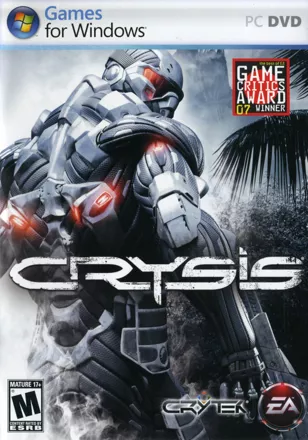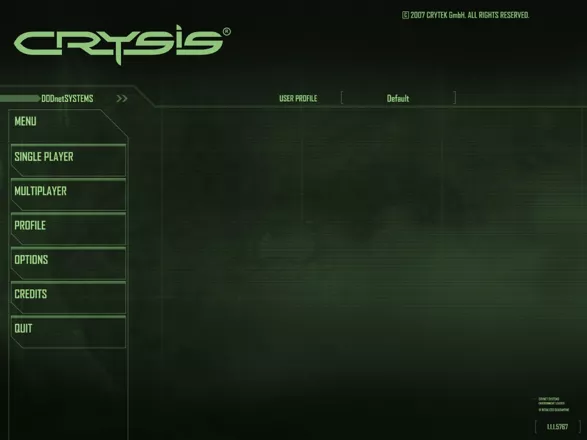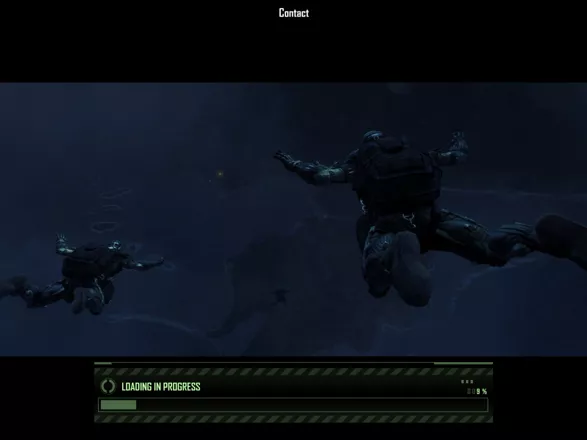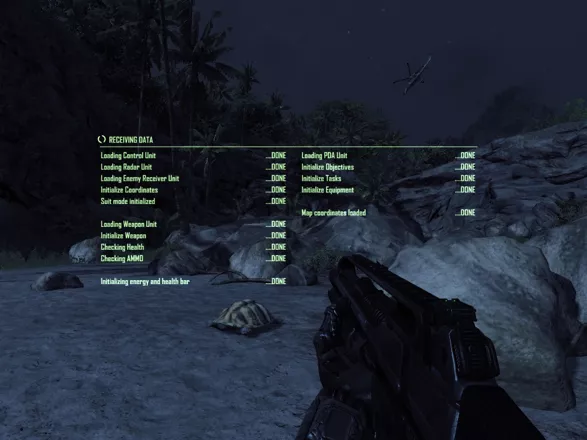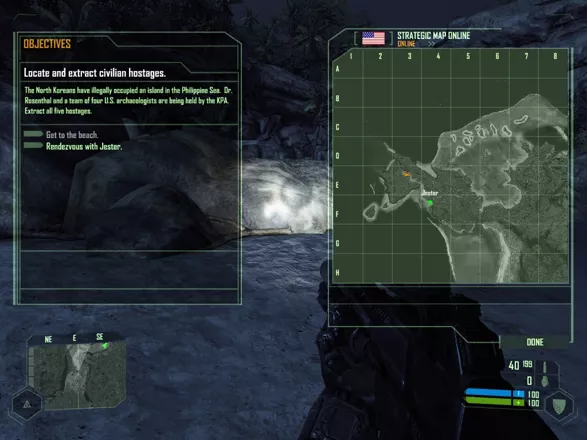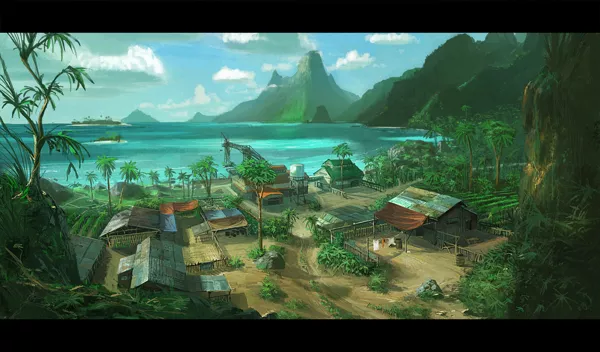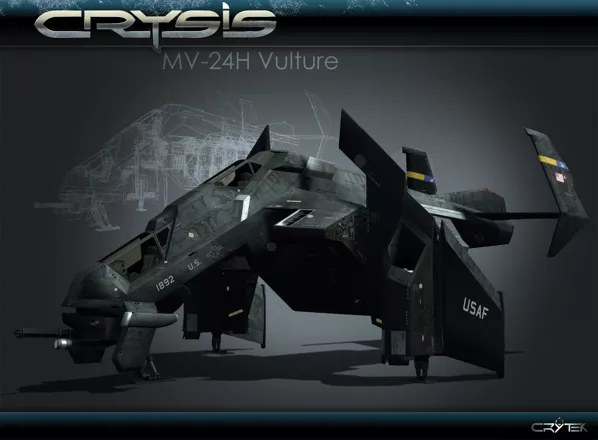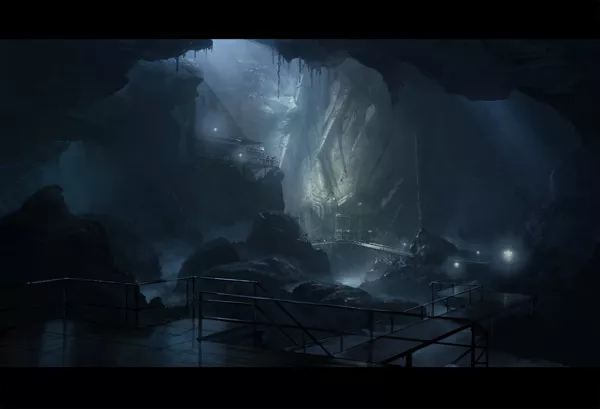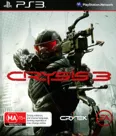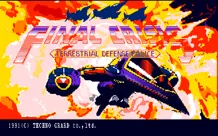Crysis
Description official descriptions
Crysis, the first game of a planned trilogy, is a first-person shooter set in the year 2020 and the spiritual successor to Far Cry. The player takes on the role of the US soldier Jake Dunn. On a remote Pacific island, a meteor has been excavated and the North Korean army quickly moved in to secure the location. After they capture a team of US archaeologists, the US Army sends in a Delta Force team to investigate and free the scientists. Most of the missions are played alone, but also often with AI squadmates that star in the cutscenes and play a crucial part in the story.
During the battles with the North Korean soldiers, it becomes apparent that there is an even greater threat. When the meteor opens up a huge alien ship is revealed that starts to xenoform the island by freezing it over. The Americans and North Koreans are forced to join forces when alien machines emerge from the vessel and attack both sides. Now both sides have to stop the xenoforming process together.
Crysis offers a singleplayer campaign as well as an objective based multiplayer for up to 32 players. One of the main innovations of the game is the so called Nanosuit. This high tech combat suit allows the player to increase his armor, strength or speed for short amounts of time. Jake Dunn and his fellow soldiers can get into a cloaking mode, become invisible and recover health when the suit is powered up.
In the single player campaign, the player will encounter several enemy types. A large part is spent fighting North-Korean soldiers. Aliens are first encountered in a Zero-G environment once the meteorite has been breached. When leaving the meteorite, the actual alien invasion begins and the player then mainly faces small alien scouts and the larger alien hunters.
During the campaign, there are a number of more or less typical shooter weapons to be gathered, such as machineguns, a shotgun, a missile launcher, a sniper rifle, explosives, various types of grenades and a gauss gun. In the later weapons, there are also some alien weapons which can freeze opponents. Not all weapons can be held at once; they must be swapped for the ones from the bodies of dead soldiers and most of them have a limited amount of ammo. There is also an extensive weapons upgrade feature which is available from the start and allows the player to reconfigure weapon configurations on the fly. Tactical or explosive ammunition can be added, or a flashlight, a laserscope, a silencer, grenades and more. Most of the weapons have multiple firing options, from single bullets to rapid bursts.
Almost any vehicle can be driven, from jeeps to large vans, regular cars, tanks and patrol boats. Most of these have mounted weapons. Other equipment includes binoculars, nightvision, a radar with targets in the bottom left corner of the screen and a direct voice connection with other squad members.
Just like Crytek's previous game Far Cry, it comes with a sandbox editor to create new levels. The console versions do not have the expansions and do not support multiplayer.
Spellings
- クライシス - Japanese spelling
Groups +
- 3D Engine: CryEngine 2
- 3D Engine: CryEngine 3
- Crysis series
- EA Classics releases
- EA Value Games releases
- Games for Windows releases
- Games made into comics
- Middleware: PunkBuster
- Middleware: Scaleform GFx SDK
- Scripting language: Lua
- Setting: 2020s
- Setting: Destroyer / Cruiser / Carrier
- Setting: Future now past
- Setting: Ship / Boat
- Symphonic Orchestra: Northwest Sinfonia
- Technology: amBX
- Visual technique / style: Voxel graphics
- Weapon: Minigun/Chaingun
Screenshots
Promos
Videos
See any errors or missing info for this game?
You can submit a correction, contribute trivia, add to a game group, add a related site or alternate title.
Credits (Windows version)
716 People (662 developers, 54 thanks) · View all
| President | |
| CEO | |
| Managing Directors | |
| Game Director | |
| Executive Producer | |
| Senior Development Managers | |
| Development Management | |
| Development Manager | |
| R&D Development Manager | |
| Producer | |
| Multiplayer Producer | |
| Project Managers | |
| Development Manager | |
| R&D Development Manager | |
| Project Manager | |
| Lead R&D Programmer | |
| Lead Graphics Programmer | |
| Lead 3D Engine Programmer | |
| Lead Renderer Programmer | |
| Technical Lead Artist | |
| Senior Graphics Programmers | |
| [ full credits ] | |
Reviews
Critics
Average score: 90% (based on 114 ratings)
Players
Average score: 3.9 out of 5 (based on 121 ratings with 5 reviews)
The Good
The year is 2020, and in the midst of frosty American-North Korean relations, a mysterious object falls from the heavens upon a deserted archipelago, the Lingshan Islands, in the Western Pacific. For reasons unknown, the Korean People’s Army scrambles to close off the site to everyone, including a hapless American archaeological expedition, who claimed to have discovered an alien artifact that predates humanity by 2 million years. A distress call from Dr. Rosenthaal, the lead scientist, reaches the States with an ominous message: a discovery that could change the world is upon them and they need YOUR help.
America evidently, has not learned its lessons from Iraq and Afghanistan only a decade ago, and decide what the hey; let’s send in some Delta Force to finally deal with these socialist bastards.
You play as part of “Raptor Team”, which surprisingly is not the name of a junior-league basketball club, but rather a squad of five, Delta operators, with fittingly unimaginative call signs like “Nomad”, “Prophet”, “Psycho” (should have been “Chav-o”) and “Aztec” (Aztec is Hispanic, get it? Genius!). For once we get a spoken protagonist in an FPS game, unfortunately though, Nomad has nothing meaningful to say and fulfils every caricature of a stereotypical, gruff-talking, American jarhead: more curse words than Tony Montana, fanatical loyalty to the military, and the ability to rescue all of mankind in a single day and still make it back home in time for supper and a baseball game.
I assume his nickname refers to the fact that you have no idea where your objectives are half the time.
Equipped with the latest in military exoskeleton and nanorobotic technology (which is only 10 years away apparently!), and a brand-spanking pair of red, Oakley sunglasses for some reason; the “Nano-suit”, or as it should be known: the “Cloak and Croak” suit, offers at your disposal a variety of super-human abilities (not really) to gain a decisive edge over your adversaries.
Which is quite easy to do actually, when you can become completely invisible and the enemies you face have goldfish memory (e.g. “Hey I saw something!”… Maximum Stealth “Just a false alarm”… BOOM “Did you see that?”… Maximum Stealth “It was just the wind”… BOOM).
Will the elite Raptor Team retrieve the hostages from their oppressive captors or will their rescue mission rapidly turn into an escape, as they stumble upon something buried in the mountain sides of Lingshan that should have never been disturbed?
Zzzzzzzzzz……
Huh? Oh right.
Let travel back in time a bit, to the present…
In a June, 2010 review, Bit-tech.net (a UK-based computer enthusiast website) took a retrospective look at what Crysis really was, free from the astronomical levels of hype that surrounded the release of Crysis, which really hadn’t been seen since the late 1990’s when 3D Realms were continually back flipping over the release date of the long-awaited, Duke Nukem Forever (and still are). Normally, Bit Tech are a fairly impartial and thorough 3rd party when it comes to gaming opinion pieces (their bread and butter is computer hardware), but they lashed out at Crysis in scathing fashion, attacking Crytek for being an arrogant and immature developer, criticizing the story as being several shades below a brain-dead, summer blockbuster, blasting the absurdly high system requirements for their ridiculous cost-to-benefit ratio and in summarizing, claiming that Crytek wrote cheques that Crysis simply couldn’t cash.
Some people felt this review was harsh.
I am not one of those people.
However, before I lay into Crytek for the incredible nerve they had to pander this underwhelming, generic FPS as the arrival of “Next-Gen” gaming, I will briefly go over what was appealing about it.
Sex does sell, even in the video game industry, and Crysis is proof of this. For a game lacking innovation in almost every other department, it does redeem itself quite a bit through its excessive eye candy. Whatever you may have heard, been told, read or otherwise assumed about the game’s visuals is probably true. This is the best and most photo-realistic any video game has ever looked, period (Note: provided you can run it PROPERLY). Nothing has really paralleled CryEngine 2 as of the date of writing this review in 2011 (recent DirectX 11 titles like Metro 2033 and Battlefield: Bad Company 2 come close however but fall short in terms of texture size/quality, shadow/motion blur effects & lighting complexity), and it will most likely be a long time before we see another major leap in graphics rendering as big as this, mainly due to the console-centric focus most developers have nowadays.
To this day (nearly 3 and half years later), it’s still a wonderfully useful computer benchmarking tool, which speaks volumes about the ambitious engine design.
The beginning of Chapter 4 of the campaign for example, is a textbook case of pixelated ecstasy. Picture this: its dusk, pitch black, and you’re airborne dropped from a VTOL into a hellish warzone with dead bodies strewn near a river bank. The river’s water surface dips and bounces as if it’s really being affected by wind. As you make your way to the crest of a nearby hill, following a local commander, the game treats you to a wonderfully scenic sun-rise over this majestic, tropical inlet, which is now the sight of a fierce anti-aircraft and aerial bombardment battle. The sun’s rays melt through the dense foliage of a cliff to your distant right, providing excellent fog and mist effects as the sun bleeds over the horizon, changing colour from reddish-orange to fiery yellow as it rises. Below the hill you can observe the inlet becoming more and more transparent as light hits it, when the day breaks you can clearly make out rock formations and coral in the depths below. Anti-aircraft tracer rounds glow in massive formations across the clouds, like a fleet of birds set ablaze, and F-22 Raptor’s zoom overhead continuously, with roaring sonic booms, some of them exploding into fireballs. Explosions that appear almost like fireworks in their debris patterns go off in the distance, showering the skies with glowing fragments and swaying trees and plants with their shock waves. By contrast, on your side of the inlet, everything seems calm and serene, almost as if it's normal.
This literally took my breath away; that’s sounds sappy and emotional I know, but it satisfies every expectation of what you think a warzone would feel like. I hadn’t experienced such jaw-dropping exhilaration since the first time I played Call of Duty’s Battle of Stalingrad level, or when I hopped into one of those vehicular slug-fests in Halo’s campaign. It was right up there with the beginning of The Elder Scrolls IV: Oblivion, when you stumble out of the dark, wretched sewers into a living, breathing, virtual paradise.
One other part of the campaign I felt incredibly “blown away” by took place at the end of Chapter 6 – “Awakening”. You’re treated to a marvellously scripted, in-game cinematic after making your way through an intricate, entangled cave system which leads you right into the hands of North Korean General Kyong (more on him later). To cut the story short, you’re presence is quickly noticed by two cloaked, North Korean soldiers (yes, the Koreans have their own nano-suit knock-offs) who knock you out cold. When you awake, you find yourself held hostage by two of Kyong’s henchman, as you witness the stubborn General open a mysterious portal, buried deep in the cave, to what he presumes is some kind of temple (yeah, he’s not that bright). Unbeknownst to everyone however, it unleashes the cataclysmic Alien transformation (quite literally) of the Lingshan Islands from a tropical, scenic jungle to a frozen, crystallized wasteland. Very Hollywood yes, but very exciting the nonetheless. The way your visor would become covered with frost icicles if you stood still for too long or how you could smash frozen bodies by simply whacking them with the butt of your rifle were subtle details that sucked you into the new, apocalyptic world.
Being the first human to venture inside the mostly zero-gravity, Alien core is also quite a mesmerizing, albeit very brief and scripted experience. I guarantee being able to rotate yourself 360 degrees both horizontally and vertically will never get old though.
While we’re on the topic of graphics, I personally quite liked the field of view used in this game as well. If you’ve played F.E.A.R or Thief III: Deadly Shadows, then you will have seen the type of “true”, first-person camera angle used in Crysis before; e.g. you look all the way down vertically and you can see your own feet animating as you run, crouch and jump; being seated in a vehicle enables to see your arms, legs and torso. I find it just bumps up the realism factor a notch and doesn't give you that same sense of detachedness you got in the majority of FPS games before where you feel like you're simply "piloting" a floating pair of hands grasping a firearm.
There are also quite a few immersive subtleties to marvel at, like player-cast shadows. Nothing like creeping up on an oblivious North Korean soldier and watching your shadow darken the back of his head as you discreetly grab a hold of him and toss him all the way back to Pyongyang.
Or how about the wonderful distortion and blurring effects, such as when you surface after diving into a body of water and watch beads of water slide down your nano-suit visor like a car windshield in the rain? Better yet, when you happen to get injured from enemy fire or explosions this grainy, motion-blurring effect and blood/dust overlays interfere with your vision and really make you feel as though dirt and debris are flying right into your face. The motion blurring is particularly evident during explosions when debris is flung out in all directions so quickly you simply see dark blurs scattering into the air. Very slick.
This game engine literally does have more trinkets and details than a senior citizen’s mantel piece and while I can’t go through all of them here, sufficed to say, you will often find yourself stopping to “smell the roses” in Crysis, as the developers certain knew how to emphasize the engine’s party pieces and eye candy.
From a purely technical stand-point, Crytek achieved something miraculous here and they certainly do have a knack for pioneering game engines and rendering advancements, I will congratulate them on that. I can't think of a more revolutionary game engine in FPS history, aside from the first Unreal Engine.
From an artistic and creative stand-point however, they have yet to scratch the surface of what a truly "revolutionary" FPS is.
The Bad
Alright, flame suits everyone; it’s time for the shopping list of negatives.
The fundamental issue at hand here is simply this: with all this talk of Crysis being touted the first, “Next-Gen” title; the game in which the combined milestones of DirectX 10, truly malleable, destroyable environments and context-sensitive, adaptive A.I. would unite to deliver unprecedented gameplay value… almost NONE of that came to fruition.
This game is, if I can degenerate to base comparisons, the first Far Cry with sexed up graphics, flying Trigens and rudimentary weapons customization. That is all that has changed. It will play like any other FPS you have experienced in the past decade, so if you’re expecting to be blown out of your swivel-back computer chair by newfangled gameplay innovations, like this is the next Quake or something… just don’t be. Treat this just the same you would BioShock or Half-Life 2, from a strategic viewpoint.
The graphics engine for starters, which received unanimous praise, is still not without its flaws. Even though my hardware was able to handle Crysis at a resolution of 1920x1080 with Very High/High settings on everything and 4x anti-aliasing… I could spot quite a number of issues.
The surface textures of most of the terrain like grass, sand, dirt, rocks and floors are atrocious. They lack shadow volume and bump-mapping (simulation of dips and mounds in porous surfaces), and use extremely blurry and repetitive textures.
Face models look awkward; they all have this moon-face expression and random eye movements. Especially Prophet’s face (Major of Raptor Team), it’s almost like he’s having an epileptic seizure every time he speaks. The audio is totally out of sync with everyone’s lips in the cinematics and more to the point, character’s lips barely move at all. None of the animations, particularly in the face, but also the gestures people make when they interact with the environment, look convincing, rather very robotic.
The trade-mark, several-kilometre-long, draw distances that make another comeback from its predecessor Far Cry are actually counter-productive to this game’s engine because the landscape LOD (level of detail) in the distance is very, very low. Honestly, vegetation and surface textures in the distance look awful, they appear as massive splotches of mixed up colors on the side of cliffs and hills, resembling the poor landscape textures used in The Elder Scrolls IV: Oblivion that needed texture replacement packs to look decent. Distant objects like buildings are fuzzy, blurry and have almost no definition to them. Hard to miss when two-thirds of the combat in this game takes place outdoors.
Continuing on from that point, there is a hell of a lot of “pop-in” or sudden object rendering in Crysis (for things like trees, rocks, buildings, vehicles), I suppose to reduce the massive strain of rendering the huge maps the games uses, but it is impossible not to notice. The problem is that distant objects or landscapes are either totally hidden from view (not appearing until you’re close enough) or they’re blurred and rendered in lower detail the further you are away from them. However, when you move closer to them, they don’t seem to gradually fade into higher detail, but just suddenly and jarringly “morph” into the next level of detail. Imagine walking towards a palm tree which from a distance seems like a wooden stick with a green wig on it. Then you happen to get 40 feet from it and suddenly, Abracadabra, the palm tree transforms into its detailed, high-resolution counter-part. That’s what it’s like. Couple this with the fact that most maps will be populated with hundreds upon hundreds of pieces of foliage and you get an idea of how rough and unpolished this makes the game look.
A great example of this ugly, "pop-in" phenomenon I can relate, was walking to towards a giant dock (the last objective of Chapter 4), and seeing it completely deserted from a distance through binoculars (I thought this was intentional). Then you happen to get no more than a grenade throw away from it and suddenly, right before your eyes, it’s populated with enemies. The North Koreans literally “warp in”, like something out of Star Trek. Et tu Crytek?
So exactly what good are these limitless draw distances and being able to look all the way into the horizon when nothing is actually present in the distance until you’re 100 feet from it? You may as well be looking at a 2D skybox like you did in Doom.
Probably the most glaring flaw any player with a powerful rig will notice is how little of an effect turning on anti-aliasing has in this game. None of the geometry and texture edges in this game seem to be smoothed out in the least; the foliage like trees and grass is the worst, because with the massive amounts of leaves and jungle you have in this game, it just looks like a jumble of razor-sharp, green confetti (even at 8x anti-aliasing). It really is strange and makes you wonder how any 3D graphics programmer could have missed this glaring weakness.
And my final point about the engine’s shortcomings is the frame rate. You cannot get a consistent frame rate in this game. I don’t know if it’s the fact that it just wasn’t properly optimized, or my SLI configuration having something to do with it, but I would replay certain parts of the same level and on the first play through I might get an average 55 FPS (frames per second), on the second it might drop to 40 FPS, and on the third it would hover up around 67 FPS (And please don’t assume I had 150 processes running in the background or I don’t know how to optimize my rig properly. My computer isn’t the problem here. CryEngine 2 is and this is a widespread issue which you can Google to your heart’s content). Doing ANYTHING in Crysis causes the frame rate to drop, and unless you simply stand still and stare at the sky, you’ll find your FPS fluctuating up and down like a heart-beat monitor hooked up to someone having a heart attack. In some of the larger set-piece battles my FPS (which I was measuring with FRAPS) was literally going like this: 78, 32, 38, 40, 29, 55, 46, 30, 76, 80, 82, 45 and so on. It does get incredibly irritating for example when you have an enemy in your sights, and are about to squeeze off a round into his head and suddenly the game will stutter and skip ahead 5 frames, causing your shot to miss by a mile.
Now one thing you probably heard being touted as a selling point of Crysis were allegedly “Destructible Environments”. Again, flat out untrue. Where were they? As far as I could see, the only things that were genuinely and dynamically destroyable (i.e. not scripted actions repeating themselves) were metal sheds, small shacks or huts, metal sheet roofing and vehicles. That’s it. This implementation of physics-enabled, environmental destruction had nothing on Battlefield: Bad Company 2's Frostbite Engine 1.5, where you could wholesale flatten an entire map’s architecture and scenery, leaving nothing but craters pockmarking the landscape like a pimply teenager’s face.
On the other hand, if you drop a grenade or fling a rocket into any environmental surface in this game, nothing will happen (no craters, no deformation, no generic blackened soot residue, nothing). Squeeze off several hundred machine gun rounds into thin, single-brick walls and… nothing will happen. Aside from a generic host of physics-enabled objects found in pretty much all first-person shooters such as oil barrels, wooden doors, sandbags, palm trees and some novelties like mobile command and control trailers and sniper look-out posts; you could not dynamically destroy nor damage ANY part of the environment, especially any large buildings, hangars, bunkers, warehouses or rooms with any weapon in the game. A complete let-down in my mind.
The vehicular selection consists entirely of remakes of the original game’s collection. Everything is copied ad verbatim from Far Cry here, aside from a tank (which you get to pilot once, in a brief level) and a VTOL Helicopter (again, a one-trick pony). The weapons arsenal is puny and hackneyed, it’s just a generic bunch of your usual tools of the trade, an M-16 knock off (SCAR), an AK-47 knock-off, a sniper rifle, a shot gun, dual pistols, a rocket launcher, frag grenades, remotely-detonated C4, etc. Nothing to pop a champagne cork over. There is one alien weapon; however it is for all intents and purposes just a machine gun with infinite ammunition.
While the new addition of a weapons customization mechanism does offer some interesting possibilities to cater to different playing styles (e.g. Rambo Vs. Jason Bourne), a lot of the modifications and add-ons you can equip your weapons with are absolutely pointless. Chief among which is the “Tactical Attachment”, some kind of dart-gun that fires tranquilizers which will knock out a human enemy for 60 seconds. I never used this. If you can hit him with a dart, why not hit him with a friggin’ silenced bullet? He’ll never wake up and get the chance to run around, alerting everyone to your presence. The reflex sight and the assault scope become worthless once the sniper scope is unlocked (which happens in the 3rd chapter), and while the Incendiary ammunition is fun to use, its usefulness is short-lived as it's only available for the FY71 (the AK-47 knock-off) and only available in 2 chapters.
I simply found myself permanently attaching a silencer (even though it reduces power & range) and a sniper scope to every weapon that could accommodate it (the assault rifles, sub-machine gun and Gauss rifle can), simply due to the predominately long-range fire fights in Crysis and the extremely observant enemies who all know EXACTLY where you are, after you let off one round.
All in all, the weapons customization mechanic was probably the single biggest, if not the biggest, change in gameplay compared to Far Cry.
Arguably the most glaring flaw you can pick apart in Crysis is the story. The lack of innovation and imagination is just appalling; I used to dream up more well-written stories in the 7th grade while chewing bubble-gum and looking out of a classroom window. I mean, dear god… it’s 2007 and we’re treated to yet another sad chapter in the “Aliens Vs. Humans” saga. This familiar, sci-fi derived fable has been present with us in some form or another in the video game industry since mass produced, commercial video games existed.
So in this day and age, for a prominent developer to come out and do yet another clichéd retelling of this old formula, they need to be damn well sure they can significantly differentiate their product from the legions of like-minded titles. But what does Crytek do?
Aliens arriving on Earth in a meteorite? Wow. Aliens that can fly? Sigh. Aliens that have no other motivation or purpose in their lives, aside from “KILL ALL HUMANS.” Yawn. Ancient remnants of an Alien civilization that predates the existence of humanity, being discovered on Earth. I think the X-Files has a copyright on that premise. Aliens that transport themselves in gargantuan “mother ships”. Did I just step back into 1996?
There’s nothing I can tell you about the storyline that will impress even the most undiscerning, gun-porn addicted, Counter-Strike players; it is just best likened to summer, popcorn blockbusters directed by Michael Bay ala Independence Day or any other ridiculous Hollywood disaster film. The infallible Americans and their “kick-ass-and-take-names” Marine Corps save the Earth from a malignant alien threat; smash those evil, socialist bastards the North Koreans (who predictably make the situation worse) and whose motives are never even touched upon, such as: why the hell would the North Koreans be interested in a friggin’ meteorite impact in the middle of nowhere?!?!! Does the despotic military of a 3rd world nation even have the capability to detect meteorite impacts? Honestly? Is there a North Korean NASA, with its own satellites in orbit? (But hey, I guess being Communist is good enough, Communist is just a byword for Satan after all). What have I left out? Oh occasionally, the story will include some enormous explosions that’d only captivate a pre-pubescent audience. It really needs no further embellishment, and it’s also replete with plot holes large enough to drive a Supertanker through.
The cast of characters can basically be summarized as: a no-nonsense, African-American Major ripped directly from Halo’s Sergeant Avery Johnson (who in turn is plagiarized from Aliens), a cocky, loud-mouthed Brit (how the hell would a foreign national be in Delta Force?) who endlessly quips horrendous, Schwarzenegger-style one liners and… that’s it.
Everyone else either mysteriously dies within the opening hours of the campaign (Aztec, Jester and the rest of “Raptor Team”) or is wholly unexplained and two-dimensional. Dr Rosenthal (stereotypical, mad scientist working on some whacky, unbelievable theory) was apparently researching some archaeological discovery in the Lingshan islands, which correlated with similar discoveries he made all across the world, but that’s about as far as that story arc progresses. More puzzling is why the hell the North Koreans allowed an American archaeological expedition to arrive on their territory, or are we supposed to believe they covertly smuggled themselves in somehow? Bunch of professors with thick glasses, yeah that’s real likely. But hey, don’t let common sense get in the way of a good explosion, right?
Major Strickland, who’ll take charge of things when your cover is blown and your squad is decimated, is just a parody of every single Drill Sergeant in every war movie since Full Metal Jacket. Cigar-smoking, constantly shouting, the whole nine yards. Helena Rosenthal, the daughter of Dr. Rosenthal mentioned above, basically serves to warn everyone that the excrement is about the hit the fan on Lingshan, advice everyone ignores until said excrement splatters onto everyone’s faces. She also has a crush on Nomad, in a sort of Alyx Vance/Gordon Freeman way, which has become incredibly overdone in FPS games with female NPCs. General Kyong is just a maniacal, two-bit super-villain who wants to see the entire world burn and forgoes everyone’s protests for rationality and Admiral Morrison, who you encounter near the end of the game, is exactly like Major Strickland, to the point where I forgot he was a different character most of the time. Like a good Admiral though, he goes down with his ship. Sniff
It’s a stock cast of archetypal clichés that deliver B-Grade voice acting with all the enthusiasm and seriousness of a telemarketer on the phone.
What also bothered me was Nomad’s self-narration during certain chapters (like the Alien Core) and his painfully obvious wisecracks, i.e. after being dropped off by a VTOL which radios in to say it’ll pick him up later: “Yeah, you do that!”, that’s just excruciating. I like the idea of a spoken protagonist, but this is a case where a Gordon Freeman was needed, not a Captain Obvious. Do you really think you’d be talking to yourself inside a never-before-seen, Alien cave full of hostile, flying thingamajigs?
As for the Aliens themselves… Oh god. Where to start? Well quite apart from the fact that most of their physiology is ripped off from the film Predator, and their “headquarters” looks remarkably Convenant-like (from Halo), their introduction is confusing overall.
Were they going to unleash an invasion force upon the Earth all along or was it triggered by General Kyong’s “power surge” which aggravated their peaceful society into a war-frenzy? What have they been doing buried in a mountain for 2 million years and how on earth have they evaded detection from humans?
Why is their natural habitat so freezing cold?
And how exactly do all of my gunpowder-based firearms work normally in a liquid nitrogen-like environment so cold you can shatter frozen human bodies by hitting them?
How exactly do they derive “energy” from man-made power sources like electricity and why do they need to acquire foreign energy sources anyway since they’ve been self-sufficient for 2 million years apparently. There are a million unanswered and probably unconsidered questions you could point out that Crytek never intended to be asked.
The only part of the story line that engaged me on some sympathetic level was the finale and the boss battle accompanying it, and not just because it actually meant the damn game would conclude, but because it takes place on the USS Constitution (based on the now planned Gerald R. Ford-class aircraft carriers), which is probably one of the best and most creatively-rendered environments in the entire game, it almost felt life-like (quite a shame the final chapter totals some 30 minutes all up.) In all honesty it’s not a bad way to end a game, but with a storyline as poorly executed as this, it’s a bit like the icing for a cake that was never finished.
And that’s about as many keystrokes as I feel comfortable wasting on explaining the non-existent story. Moving on.
Now that I’ve gotten the little nit-picky details out of the way, here is the biggest let down in the game: it’s too easy and too short. The “Nano-suit” concept fails miserably and was not properly thought through.
None of the suit’s four modes of operation are terribly useful aside from cloaking, and more to the point, watching the introductory cinematic gives the impression of a seriously high-tech, Batman-like suit with a host of purposeful utilities that you can transition to on the fly. Instead, all you’ll find yourself doing with the Nano-suit is switching on cloaking mode, then switching to armor mode to recharge your suit’s energy and then repeating this process infinitely.
Strength Mode, which you’d assume would allow you to summon the strength of a Hulk and flip vehicles over or push a boulder off a cliff onto an enemy camp, rather just makes it seem like Nomad can pole vault and has fists made of cinder blocks.
You can kill enemies with one punch, which sounds appetizing, but be aware when you do you will create a lot of noise launching a solider into a wall or a pile of barrels and every enemy within a 200 foot radius will be aware of your presence (much smarter to simply use a silenced weapon). You can also execute vertical leaps of 12 feet or more, which I admit is handy for sniper-oriented players like myself but nevertheless a lot of the rock and cliff surfaces you try to climb in the game are so slippery that even if you can land on them, you’ll just slide right off in a second or two. I must have spent a good hour or two of the total campaign just trying to scale cliffs and hills with Strength Mode but finding them to made out of greased, playground slides.
Speed Mode will allow you to run as fast as a speeding Humvee in the game… for a total of 3 seconds (so you can forget about dodging explosions or bullets like Neo in The Matrix, by the time you open the Nano-suit menu and select Speed Mode you’re already dead). After a 3 second sprint your suit’s energy is completely shot and needs to recharge. The only real benefit of speed mode is that your normal walking pace becomes as fast as your running pace in any other suit mode.
Armor Mode is the default mode of the Nano-suit and consequently the most insignificant. It only lets you take 2 or 3 more bullets before you die, than you could in any other mode. Once your “armor shield” is depleted, it’ll need to recharge before it can provide maximum bullet absorption, so if 3 or 4 guys have you in their sights then it offers next to no protection.
Now as if Crytek somehow wanted to make up for these uninspired and futile gimmicks, they decided to make the Cloaking ability of your suit completely and utterly overpowered. They may as well have just included a “God Mode” option because it would have achieved much the same effect.
The result is that they have unintentionally created a stealth-based shooter, but without any of the trappings and intricate dark-and-light based gameplay or evasion/detection principles of a Splinter Cell title or a Hitman title.
Let me explain, in case I’ve made you pull an “O RLY?” face. Your Nano-suit gives you the ability to cloak, but to sort of restrain you from going all “Predator” on the hapless Koreans and Aliens, your suit’s energy supply drains very quickly if you walk or run while cloaked. However, when crouch-walking it’ll give you a good minute or more of invisible movement (even more if you’re prone, but of course you’ll move like a slug), during which nothing in the game can see you, unless you literally breathe down an enemy’s neck or fire/use any weapon. This basically forces the gameplay into a familiar routine: Cloak, Kill, and Hide. Rinse and repeat for every enemy in an entire base and then move on to your next objective.
Playing the game like this, you have the capability to wipe out entire camps of enemies with total impunity and the A.I. are none the wiser to the fact that dead bodies are scattered all around them in a 60 foot radius or that a comrade of theirs standing no more than 20 feet from them has had their head blown off. It quickly devolves into a ridiculous, one-sided affair; particularly when you know how to exploit the A.I.’s fundamental lack of situational awareness. They’re able to notice flashlight beams in the distance or the noise you make knocking a glass bottle off a table but yet are incapable of hearing a grenade going off downstairs, a Humvee screeching past in the jungle or a 250 pound Marine in a metal suit stomping around on concrete right behind them (as far as I know cloaking does not equal inaudibility).
It’s just laughable how little effort went into balancing your Nano-suit’s overpowered cloaking ability against the weak A.I.
That being said, if you try to play this game without using cloaking, you suddenly start dying quite a lot. Your enemies aren’t terribly accurate but a couple of rounds on Hard or “Delta” difficulty will drop you like a ton of bricks (snipers, rockets & machine guns will kill almost instantly). Also, within seconds of you being spotted, the enemy will almost always call in reinforcements, i.e. helicopter gunships or more troops/vehicles, and this just means you’ll die incredibly fast. Compounding the very high lethality of weapons in Crysis is the fact that enemy fortifications and bases are extremely, densely protected with numerous machine gun nests, sniper posts, heavy weapon emplacements and even tanks, boats and helicopters in later levels. This makes anything other than silent infiltration a suicidal approach.
Does this make the enemies intelligent? Hardly, there is almost nothing dynamically adjustable or context-sensitive about their behaviour. They’ll either do one of two things when idle: carry out scripted patrols in a continuous loop, with horrible path finding I might add, to the point where half a patrol is usually stuck behind a rock while the other half is on the opposite side of the map. Or if they’re not patrolling, they’ll stand around on high perches, making excellent sniping targets. I rarely recall the enemy A.I. performing flanking manoeuvres or suppressing me with grenades, it’s more of a case of WWI-style infantry wave tactics; they’ll just run right towards you while firing. Clever.
Sometimes they’ll hop into vehicles and attempt to scout around on wheels looking for you… too bad they’ve never heard of remotely detonated C4.
Honest to god, you can find smarter artificial intelligence in a Super Mario title. At least the toads in that game jump out of the way of your fireballs. I found no difficulty placing C4 on walls, right behind machine gunners and snipers while cloaked, running off to a safe distance and vaporizing them without any other soldier making a peep. Then when they all rushed to the scene of the explosion, like a group of hysterical bystanders at a car crash… rocket launcher up the ass. Even if you’re a below average FPS player, the kind who was always getting killed in Counter-Strike before you even left the spawn zone, you will have NO difficulty wrapping the A.I. in this game around your little finger and toying with them (even on Hard/Delta difficulty).
One other strange glitch with the A.I. behaviour is that they tend to “spook” themselves unwittingly. Like in the previous Far Cry, they have different levels of alertness depending on how aware they’ve become of your presence (noises, sightings, etc.), and their map icons on your radar screen will change color to indicate this. However, due to a whole host of weird physics bugs in Crysis, the KPA soldiers will quite often walk around, bump into something or knock something over, thus creating a large noise, which will then elevate their alertness level to the maximum causing them to act completely hysterical. It’s not unusual to see to the Detection Gauge in your HUD jump all the way up for absolutely no reason when you’re fully cloaked and a good distance from an enemy base simply because some bumbling idiot walked into a pile of boxes and scared himself senseless. I once even remember a KPA soldier calling in reinforcements due to a collision with a table. You can’t make this stuff up.
So what we have here is a first-person shooter, which due to the ineptness of the developers in balancing the player against the enemy has turned itself into a stealth-action game, but because it wasn’t intended to be Metal Gear Solid, and the A.I. were not programmed to be highly responsive and watchful (or even awake for that matter), it’s just like shooting fish in a barrel, wait scratch that, fish in a jar.
My final complaint is that, with a game that utilizes map sizes of up to 64 square kilometres, you would be forgiven for expecting a lot of “sand-box” type, unscripted gameplay with no two play throughs of the same level happening in the same fashion. But you’d be wrong. Looks can be deceiving, and just the same way that Far Cry allegedly claimed to be a free-roaming game with multiple ways of completing the campaign, Crysis turns out to be as linear as Doom 3 or Quake 4. The only difference is that like in Far Cry, Crysis simply offers the player parallel linearities to choose from.
This essentially means that, when you’re given an objective (typically: “Go into Base X and Collect Y”), there are: at the least 2, and at the most 4 approaches to completing your objective. There’s the head-on, “guns blazing” way in which you just waltz in through the front door and subsequently get blown all the way to Idaho because it’s just a kamikaze mission trying to take on the game’s adversaries toe-to-toe. Then if you explore hard enough, you may discover a hidden path which will lead you on an obscure trip around the perimeter of the base, sneak you through the defences and neatly deliver you right next to your objective without having fired a shot.
In addition to this there are usually to some over-looking hills or cliffs in the vicinity of most objectives that will afford you good sniping opportunities provided you have an hour to spare in climbing up them with Strength Mode and slipping to your death about 200 times before you reach a high enough ledge.
So in reality… this leaves you, most of the time, with just one way in (crouch-walking while cloaked to the objective). Hence it’s as linear as any other FPS game.
Those massive, wide-open jungles and miles of pristine beaches are just eye-candy and serve zero purpose to explore as there’s nothing in them and they’ll lead you nowhere. I mean some levels even give you a bunch of “optional objectives” which serve no purpose in furthering the storyline and give you absolutely no significant gameplay advantages. I feel these were thrown in just to give the player some kind of incentive to actually explore even one-quarter of the gigantic maps, because otherwise, straying off the beaten path in Crysis just ends up wasting enormous amounts of time.
This game may not be a labyrinth-style, corridor maze like F.E.A.R but it doesn’t offer much more flexibility to the player in coming up with their own, non-scripted methodology of completing objectives. You basically just get “wide corridors”. That’s it.
On a final note, this game was shipped with more bugs than a nursing home, not to mention the highest minimum system requirements ever seen and some poorly optimized code. Apparently 1 million lines of code to be exact, so you would think they’d take beta testing seriously, but no… this is Crytek.
Personally, I frequently experienced random crashes to desktop (particularly in the second half of the game), the motion blurring and other graphical settings turning themselves off every time I started up Crysis, forcing me to switch them back on, and strange graphical anomalies like explosions and particles appearing for no reason. Physics glitches galore I also came across, clipping through solid textures, being able to circumvent the borders of the map (kind of like a flyhack), horrible collision detection with many physics-enabled objects (can’t remember the number of the times I knocked objects around simply by looking at them), not to mention that trademark, crazy “vibrating” effect when a bunch of physics objects became “stuck” together after an explosion and the ragdoll physics went haywire.
I will spare you from going into system requirements debate at length here, as this has been covered to death all over the Internet but sufficed to say in 2007, you would've needed to shell out around $2500 dollars (US) to have a computer capable of running this game with all the graphical options and eye candy maxxed out, at a widescreen resolution (i.e. 1680x1050 and above) and not have the frame rate dip into Power Point levels.
That seriously alienates a good majority of the gamer demographic (who are mostly young, unemployed and can’t squander thousands on computer hardware), and more to the point why should anyone pay top-dollar for this game? Not only is it generic and a rehash of everything that’s been accomplished in the past decade, but to even play this properly, the way it was intended to be seen, you need to upgrade your computer?
So for the average, cash-strapped gamer, it will simply look and feel no better than an average Xbox 360 or PS3 title. That is completely counter-productive to a PC exclusive game in the first place, because as we all know, the computing power of even an average PC trounces the pitiful consoles’ capabilities by leaps and bounds, and thus we should be getting the long end of the stick in the visuals department. Instead we get a baseball bat over the skull.
Crysis may have done the world of PC gaming a service by for once saying, we don’t care about the console market unlike everyone else, we want to dedicate ourselves to the platform that gave birth to video gaming, and show the true potential of modern graphics rendering. I’ll admit that. However, they did themselves and everyone who bought this title a serious disservice by not only ripping off everything that had ever been attempted in FPS history and essentially remaking the first Far Cry with the exact same type of gameplay, but also because they have now seriously popularized this sad era of “Graphics Porn”.
Do I need to elaborate on that? Anyone remotely familiar with FPS games within the last 5 years or more will have noticed the rising trend of simplified, dumbed-down and imitative first-person shooters who attempt to mask their shortcomings and flaws with a dazzling layer of graphical diversion.
If you're really struggling to conjure up examples, here: Alien Vs. Predator, Soldier of Fortune: Payback, Tom Clancy’s H.A.W.X., Avatar, F.E.A.R. 2 Project Origin, Command and Conquer 4: Tiberium Twilight, BioShock 2, Dawn of War II, Supreme Commander 2, Call of Duty: Modern Warfare 2, The Sims 3. There’s some examples.
This is what the modern First-Person Shooter is rapidly becoming and it’s only getting worse. Graphical, superficial splendour in excess, at the expense of imagination, evolution, enjoyment, complexity, story-telling prowess and re-playability (this is usually coupled with an obsession for massively-multiplayer-gaming/achievements/unlockables/ladders, etc…). This epidemic is particularly widespread amongst sequels of once popular franchises.
The Bottom Line
If you’re still reading by this point, thank you; I’ll assume you either agree with my opinion (to whatever degree) or are an open-minded individual, capable of hearing out the other side of the fence without resorting to yelling out profanity-laden, “l33t speak”.
Let’s look at it this way: the idea of Far Cry once was interesting. Take the most beautifully exotic and seemingly serene locale you can think of it, and turn it into the site of a chaotic slugfest. Divide the campaign up into two “halves”, with the first being a proverbial walk in the park against dim-witted humans and the second, a mercilessly brutal struggle against over-powered, “non-humans”. Throw in some incredibly large levels, with the objectives evenly spaced out from enemy camp to enemy camp, and a host of generic vehicular companions to make travelling a breeze. Top it off with a grandiose boss battle at the end and voila… that was the innovative and new-fangled Far Cry of 2004 that everyone knew and loved.
(Notice how I could have just as easily been talking about Crysis above?)
Being fooled once however, is quite frankly enough. 4 years after the fact, re-releasing the first game pretty much as it was, but simply all dolled up with DirectX 10 is just shameful. Crytek are a very inexperienced developer in this industry (only 4 titles produced so far), and it does show. Their expectations of what they think the demographic wants, as opposed to what we really want, are incredibly cynical, low-brow and condescending. This whole game could have been drawn up over a coffee break and it most likely was, in my opinion, it feels like 60% of the resources and development were allocated to the game engine’s graphics and 40% to marketing. Everything else was simply reworded and retooled from Far Cry and thrown right back into the mix with CryEngine 2 as a clever distraction from that fact.
Everything about Crytek as a developer gives the impression of an arrogant, cheap, gimmicky, soulless and very shallow corporation. They epitomize style over substance. They blamed the poor early sales of Crysis on file-sharing piracy, which is to hopeless video game developers what Al-Qaeda is to hopeless governments: a convenient distraction (note: Crysis has sold over 3 million copies now, making it one of the best-selling PC games of all time, outselling its predecessor even. Take that Cevat Yerli). The real reason no one bought Crysis when it came out is because teenagers didn’t have the budget for it. This game revolves around its graphics, hence it mandates a powerful computer, otherwise there is seriously little else to enjoy, and most people got the hint from the demo. No sensible individual buys software their computer cannot run as intended (not to mention the outrageously understated system requirements). The Gamebryo Engine, Unreal 3, Dunia (used in FarCry 2 by Ubisoft) and even the upgraded Source Engine used in Half-Life 2: Episode Two delivered more-than-adequately-realistic visuals around the same time, for far less hardware investment and proved you don't need a personal supercomputer to have that "Next-Gen" look. You cannot make eye candy the centrepiece of your game, period. It will not stand up to scrutiny and it will age very badly, which is exactly what has happened to Crysis. The hypnotizing effect of “Next-Gen” graphics is very short-term and after that sheen wears off the gaming community usually tends to backlash once they come to their senses and realize they’ve been ripped off.
Cevat Yerli (CEO of Crytek) made an innumerable amount of promises about this game that turned out to be bare-faced lies (e.g. another planned chapter where you would unite with the North Koreans and defeat the Alien presence on the island at the very end of the game). He also totally disregarded widespread complaints from the fan base after Far Cry was released, chief among which was: had the game not devolved into a cramped, linear, corridor slugfest with Trigens half-way through that reminded everyone of Doom 3, it might have been one of the best FPS games of all time. On the contrary he decided it would be a great idea to replicate the one aspect that was universally hated about Far Cry.
They really don’t have their hearts into satisfying consumers, upholding promises or revolutionizing gaming. It’s become about the bottom-line and about milking the faded glory of Far Cry, just like EA or any other mega-developer. The successor to this woefully inadequate drivel, Crysis 2, is the ultimate proof of this. It was developed first and foremost for the console market ($$$), ported to the PC in horrendously sloppy fashion (no graphical options, “checkpoint” saves, no more big outdoor maps, no straying off the rails, “nerfed” nano-suit) and is a major step down in every single aspect from its prequel (even graphically for god’s sake, DirectX 9 in 2011? Are you friggin’ kidding me?).
I foresee Crytek going down a very predictable path in the future, a path that we’ve witnessed far too many times and that has ruined far too many good gaming franchises. More than any other tangible complaint I can conjure up about the game itself and how it’s just a regurgitation of Far Cry; my main argument with Crysis is more about principles than anything else. If you simply exaggerate your way into the attention span of every gamer on the planet with your fantastical list of lies about how revolutionary your title will be, and trailer after trailer of audacious hype, and then proceed to release a game that is not only like every other game we’ve played in the last 5 years but also exactly like it’s prequel… that is the pinnacle of arrogance and egotism in my mind. Crytek do not deserve anywhere near the attention or popularity they have received in recent years.
They are the premiere example of everything that is wrong with video games and particularly the First-Person Shooter genre as a whole, and if you overlook that, well then you deserve to be treated like a cash cow that wants nothing but console ports of rehashed concepts time and time again. Do yourself a favor and don’t sink to their level.
Windows · by Sharafciger (34) · 2011
The Good
I played it on hard difficulty and the gameplay was actually quite good and presented a decent challenge, at least in the beginning. You can pick a number of approaches to any of the open-ended areas. Things are sometimes spiced up by including enemies with suits similar to your own. The first time they appeared and surprise you, you're forced into a difficult close-combat battle, while in the rest of the encounters you can pick them off from afar.
The game feels very Hollywood-ish. Heck, it's better than Hollywood. You're the wearer of an exclusive "muscle nano suit" working for the US government and your squad consists of the typical action macho men and it really feels like a highly interactive movie that just lasts and lasts.
Oh right, and the graphics. Well, they're great. I had to play on low settings so I didn't get to appreciate them fully, but even I could see that there's tons of detail everywhere in houses, outside,... Crysis really takes things to a new level. It's a shame that the terrain isn't more destructible. Of course the super detail and huge levels means this will never run on consoles, but that's a small price to pay.
The Bad
The AI is not so great. Although they continue shooting if you turn cloak mode on in front of them, if you turn a corner and then turn it on they lose you easily. You can (as I have) take out entire bases like this; unhide-shoot-hide-cloak repeat until nobody comes out any more. Works best without the silencer so the entire base can hear you and come rushing. And no, they never learn. Similarly you can shoot someone at a machine-gun nest and another will man it, and they repeat this until they are all dead. They don't move in group or anything like that, unless you encounter a patrol, which is easy to get around since the areas are so open.
You can't move bodies or anything like that to avoid alerting others, and in fact the bodies themselves disappear after a minute or so. I suppose that's necessary since you're killing tons of Koreans and having a huge pile of them would be somehow absurd.
When you finally get to shoot aliens,... all your weapons and mods are taken away. Ugh. That meant I had hoarded all those granades, HE ammo etc just to have it disappear in the middle of the game? Wow, thanks for that wonderful game mechanic. They even take away my favourite gun, the Gauss rifle.
The game can be a bit too Hollywood-ish at times. Watch the opening scene in the demo and if you don't roll your eyes, you should be fine on the rest.
The Bottom Line
Crysis can be very fun if you enjoy the sanbox playstyle, or if you enjoy action movies. It manages to merge high quality productions with good if not revolutionary gameplay into a great cinematic experience.
Windows · by dorian grey (243) · 2007
The Good
I still remember when i upgraded by PC in 2004, the first game I used to test the card was Farcry. I basically saw the previews on TV & was impressed with its visuals but wasn't expecting much from the game. After completion of that game I was pretty much impressed with Crytek who pretty much focus on the overall aspect of a game.
Skip to 2007 and Crytek are back with a new engine, a new publisher and new intellectual property called "Crysis". Crysis is advertised as a Tactical Shooter that will refresh the stagnating FPS genre and also take visuals to a new level. It's safe to say that Crysis does as advertised.
First of the visuals are one of the best around. It has a very authentic feel, even indoors without overdoing it. Many other games use excessive bloom, blurring and some even end up looking plastic with all that shininess but Crysis is as real as games can get. I couldn't play this game on high, so I used a mixed setting it still looks brilliant.
The gameplay is pretty much non linear until the latter part of the game. The levels are pretty much the same sandbox style of Farcry. You have a choice on what path you want to take and how you get about doing it, that's where the nano suit comes in. With the nano suit you can increase your armor, speed, strength and also cloak yourself. At first I thought the Nano suit is a gimmick but after playing the demo it proved it was an integral part of the gameplay. The weapons also have real time customization, you need to acquire the parts like laser sight, assault scope etc by picking up weapons from the Koreans which have these attached. You can modify your shotgun to have a laser sight or torch.
Also unlike Farcry there is some diversity in Crysis with the environment. At first you start off in the tropical island setting then end up in a alien ship to an Arctic like island and finally a navy ship.
The A.I is average, not much improvement from Farcry but still pretty tough even on normal. Mid game you battle Koreans with the Nano suit.
The games length is just about right on FPS standards. Voice acting is perfect and the storyline is not so great. The cut scenes are from first person perspective and are executed perfectly. There seems to be a lot of Matrix and Independence Day influence in the art direction.
The Bad
The characters are pretty cliched. You got a sophisticated but relentless African American "Prophet", A drunk cussing loudmouth British "Psycho" and the Hot scientist Dr. Rosentall who is also a closet furry just like Alyx from HL2. She keeps transmitting stuff like Trojans and furry porn into your suit to weaken the aliens. Apparently aliens don't like cats. Not to forget the Admiral character.
Sometimes I felt that you're seriously outnumbered, but this was okay since it added some challenge.
The Ending of this game was cool but will be disappointing to many as it's a cliff hanger. Expect an expansion pack. The game sucks towards the end. The storyline and dialogs aren't too great either.
The game has steep requirements.
The Bottom Line
If you have a high end PC or even mid range, I highly recommend this game. It's all that it was hyped up to be and one of the best games I've played in recent years. Its opened ended gameplay will have some re-playability too. Good job Crytek.
Windows · by dreamstealer (126) · 2007
Discussion
| Subject | By | Date |
|---|---|---|
| Unavailable Quality Setting | Wormspinal (619) | Oct 24, 2008 |
| Credits | Thomas Terl (170) | Feb 12, 2008 |
Trivia
1001 Video Games
The PC version of Crysis appears in the book 1001 Video Games You Must Play Before You Die by General Editor Tony Mott.
GameTrailers
The review team at GameTrailers.com removed Crysis from their best graphics award of ''GameTrailers Game of the Year Awards 2007''. They claimed they spent a week upgrading their rig and still couldn't get Crysis to run properly.
Online servers
The game's online servers (which were hosted on GameSpy) were scheduled to shut down on 30 June 2014, like for other Electronic Arts titles in the wake of GameSpy's total closure.
References
Many fans discussed the aliens in the Paradise Lost level being a very similar to the squids seen in the cult-movie The Matrix. The game developers have never taken an official stand on it.
In the very last level of the game, Prophet says: "They're coming through the fucking walls!", which is a rephrasing of the famous quote "They're coming outta the goddamn walls" from the cult-movie Aliens by James Cameron.
Parody
Crysis was parodied in an episode of "Die Redaktion" (The Editorial Team), a monthly comedy video produced by the German gaming magazine GameStar. It was published on the DVD of issue 02/2008.
Awards
- Games for Windows Magazine
- March 2008 - #7 Game of the Year
- GameSpy
- 2007 – #8 PC Game of the Year
- GameStar (Germany)
- Best PC Game in 2007 (Readers' Choice)
- Best PC FPS in 2007 (Readers' Choice)
Information also contributed by Franziska Lehnert, Patrick Bregger, and PCGamer77.
Analytics
Related Sites +
-
Crysis
Official game website -
IGCD Internet Game Cars Database
Game page on IGCD, a database that tries to archive vehicles found in video games.
Identifiers +
Contribute
Are you familiar with this game? Help document and preserve this entry in video game history! If your contribution is approved, you will earn points and be credited as a contributor.
Contributors to this Entry
Game added by Thomas Terl.
PlayStation 3 added by SplatterDeath. Xbox 360 added by Sciere.
Additional contributors: Sciere, Niccolò Mineo, Cantillon, Patrick Bregger, Plok, Victor Vance, FatherJack, Zhuzha.
Game added November 17, 2007. Last modified March 17, 2025.


